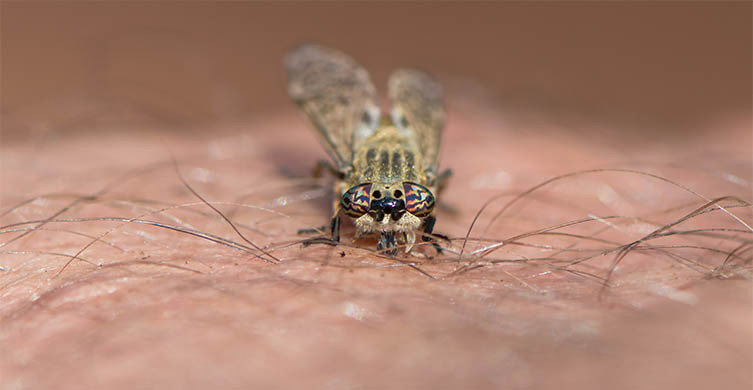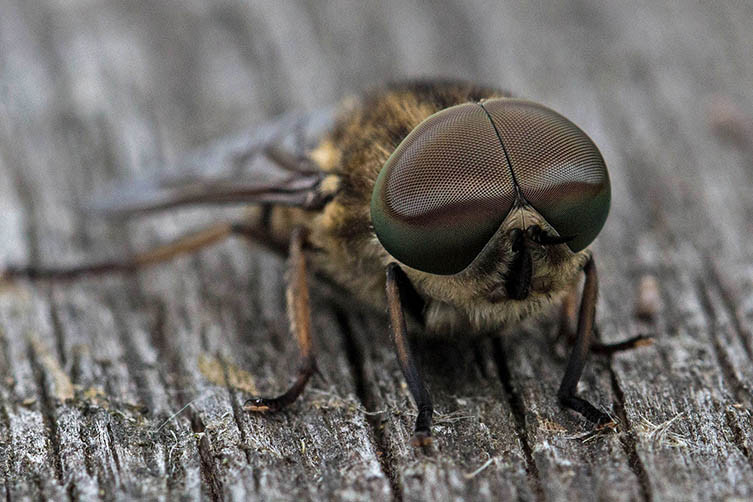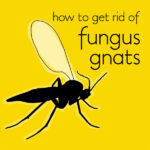As summer approaches and temperatures rise, many of us eagerly anticipate spending more time outdoors. However, this season also brings with it the unwelcome presence of biting insects, notably horseflies. These robust flies are notorious for their painful bites, leaving many to wonder, “Why do horse flies bite?” and “Are horsefly bites on the rise?”
To address these questions and delve deeper into the world of horseflies, we consulted Dr. Daniel Whitmore, a Senior Curator of Diptera and Siphonaptera at the esteemed Natural History Museum. With his expertise, we can unravel the reasons behind horsefly bites, understand their behavior, and learn how to protect ourselves from these persistent pests.
The Female Factor: Why Only Female Horseflies Bite
One of the most intriguing aspects of horsefly bites is that not all horseflies are culprits. In fact, only female horseflies possess the biting mouthparts necessary to pierce skin and feed on blood. This blood-feeding behavior is crucial for female horseflies as they require a protein-rich blood meal to develop their eggs after fertilization.
Dr. Whitmore explains, “They need a high protein input to help develop their eggs after fertilisation.” Male horseflies, on the other hand, do not produce eggs and therefore have no need for blood. Instead, they primarily feed on nectar, playing a role in pollination.
 Horsefly biting skin
Horsefly biting skin
The Mechanics of a Horsefly Bite: Serrated Mandibles and Anticoagulants
Unlike the subtle bite of a mosquito, a horsefly bite is often described as brutal and painful. This is due to the horsefly’s feeding mechanism. Female horseflies use a pair of serrated mandibles, essentially tiny, saw-like jaws, to lacerate the skin. These mandibles cut and tear through the skin until they rupture small blood vessels, causing blood to flow to the surface.
To facilitate their blood meal, horseflies inject saliva containing an anticoagulant. This substance prevents the blood from clotting, ensuring a continuous flow as the fly sucks up its meal. Unlike mosquitoes, horseflies do not inject an anesthetic, which contributes to the immediate and sharp pain associated with their bites.
Dr. Whitmore notes the evolutionary reason behind this crude biting method, “The horsefly bite is much less sophisticated, likely because usually they have to pierce through much tougher skins than ours when they are feeding on a cow or a horse.” While horses and cattle are their primary targets, horseflies are opportunistic feeders and will target any large mammal, including humans, when detected.
Are Horsefly Bites Dangerous? Understanding the Reactions
For most individuals, a horsefly bite results in a raised, red, and itchy bump, accompanied by localized pain and sensitivity. However, the severity of reactions can vary. Some people may experience more pronounced symptoms, including:
- Allergic Reactions: In sensitive individuals, horsefly bites can trigger allergic reactions. These reactions can manifest as dizziness, widespread swelling, hives, and even fluid-filled blisters that can become infected if scratched.
- Secondary Infections: Due to the nature of the bite and the potential for scratching, horsefly bites can become infected. Signs of infection include increased pain, redness, swelling, pus, and fever.
If you experience signs of an allergic reaction or infection following a horsefly bite, it is crucial to seek medical advice promptly.
Identifying Horseflies: Size and Distinctive Eyes
Identifying a horsefly can be helpful in understanding and avoiding these biting insects. Horseflies are typically larger than many other biting flies, making them relatively easy to spot. Key identification features include:
- Size: Horseflies are generally robust and larger than houseflies or mosquitoes.
- Eyes: Many horsefly species have brightly colored and patterned eyes, which are particularly noticeable. In male horseflies, the eyes are exceptionally large and meet at the top of their heads.
Horsefly larvae often develop in aquatic or semi-aquatic environments, leading to a higher prevalence of adults near bodies of water. Farms with livestock are also hotspots due to the flies’ attraction to cattle and horses.
 Male horsefly sitting on wood
Male horsefly sitting on wood
Minimizing Horsefly Bites: Practical Tips for Prevention
While horsefly bites can be unpleasant, there are steps you can take to reduce your risk of being bitten:
- Cover Up: Wearing long sleeves, trousers, and socks can create a barrier against horsefly bites. However, Dr. Whitmore cautions that “Horsefly females have such strong, powerful mouthparts that they can sometimes bite you through your clothes.” Loose-fitting clothing is recommended as a better deterrent.
- Avoid Scented Products: Horseflies, like many biting insects, can be attracted to floral or sweet scents. Opt for unscented toiletries and detergents when spending time outdoors.
- Limit Outdoor Activities During Peak Hours: Horseflies are most active during daylight hours, particularly in warm and sunny weather. Minimize outdoor activities during these peak times, especially near water bodies or livestock areas.
- Use Insect Repellents: While effectiveness against horseflies can vary, insect repellents containing DEET or picaridin may offer some protection. Apply repellent to exposed skin and clothing, following product instructions.
- Stay Indoors During Heatwaves: Horsefly activity tends to increase during heatwaves. If possible, limit outdoor exposure during periods of intense heat to reduce encounters with these flies.
Horseflies’ Ecological Role: Beyond the Bite
Despite their annoying bites, horseflies play a significant role in the ecosystem. In the UK alone, there are around 30 species of horseflies, and globally, over 4,500 species exist. While female horseflies are blood-feeders, male horseflies are important pollinators.
Male horseflies feed on nectar, visiting various flowers and contributing to plant pollination. Some horsefly species have even co-evolved with specific plants, developing elongated mouthparts to access nectar from long-tubed flowers. This intricate relationship highlights their crucial role in plant reproduction and biodiversity.
Furthermore, horseflies, in both their adult and larval stages, serve as a food source for a wide range of animals, including birds, bats, and fish. They are an integral part of the food chain, supporting populations of other species and contributing to ecosystem balance.
 Horsefly sat on skin
Horsefly sat on skin
Conclusion: Coexisting with Horseflies
While horsefly bites can be a nuisance during the summer months, understanding why horse flies bite and their ecological significance can foster a degree of tolerance. By taking preventive measures and appreciating their role in the natural world, we can better coexist with these often-misunderstood insects. They are not simply pests but a component of a complex ecosystem, playing a part in pollination and serving as food for other wildlife. So, while protecting ourselves from bites is advisable, recognizing their broader importance encourages a more balanced perspective on these summer inhabitants of the UK and beyond.
